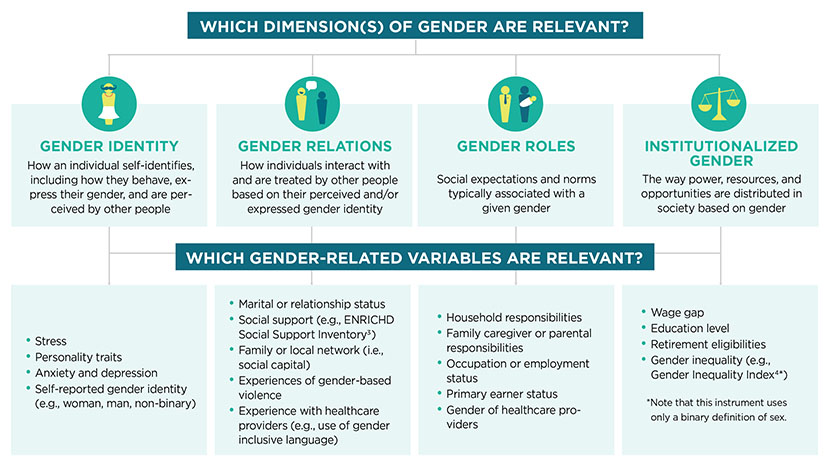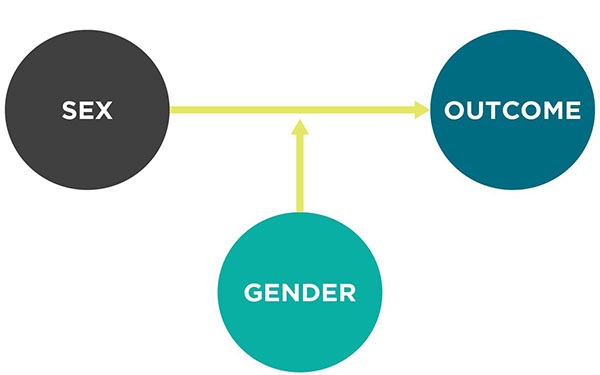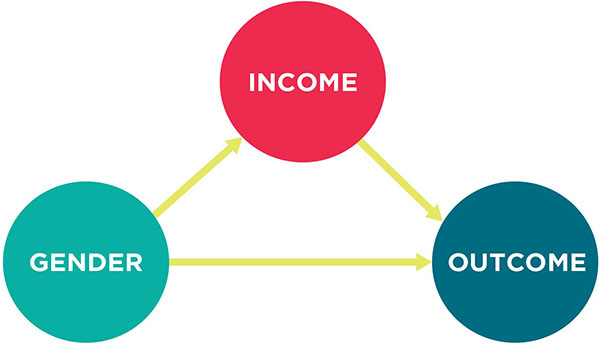Meet the Methods series: Methods for Prospectively and Retrospectively Incorporating Gender-Related Variables in Clinical Research
Issue 4 – July 2021

Gender Outcomes INternational Group: to Further Well-being Development (GOING-FWD) is a data science and personalized medicine project funded by CIHR and GENDER-NET Plus, which uses data from over 30 million patients with chronic disease across Canada and four European countries. The project is led and coordinated by Louise Pilote, MD, MPH, PhD, a researcher at the McGill University Health Center Research Institute and a James McGill Professor of Medicine at McGill University. Co-leaders are Valeria Raparelli, MD, PhD, Assistant Professor of Internal Medicine at the University of Ferrara (Italy), and Colleen M. Norris, RN GNP, PhD, Professor of Nursing, Medicine and Public Health Science at the University of Alberta. In this Meet the Methods sheet, Louise Pilote, Colleen M. Norris, and Valeria Raparelli discussed methods for prospectively and retrospectively integrating gender-related variables in clinical research.
Deciding which gender-related variables are relevant to your clinical study
What is a gender-related variable?
A gender-related variable is a non-biological variable which differs in terms of magnitude, prevalence, and/or impact between people of different genders. Gender can be broken down into four dimensions: gender identity, relations, roles, and institutionalized genderFootnote 1. A gender-related variable may fall under any of these domains. Researchers may want to focus their inquiries on a single dimension, or measure variables across multiple dimensions. Below are a few gender-related variables you may want to consider. Find more examples of gender-related variablesFootnote 2.

Long description
Which dimension(s) of gender are relevant?
- Gender identity: How an individual self-identifies, including how they behave, express their gender, and are perceived by other people.
- Gender relations: How individuals interact with and are treated by other people based on their perceived and/or expressed gender identity.
- Gender roles: Social expectations and norms typically associated with a given gender.
- Institutionalized gender: The way power, resources, and opportunities are distributed in society based on gender.
Which gender-related variables are relevant?
- Gender identity: Stress, personality traits, anxiety and depression, self-reported gender identity (e.g., woman, man, non-binary).
- Gender relations: Marital or relationship status, social support (e.g., ENRICHD Social Support InventoryFootnote 3), family or local network (i.e., social capital), experiences of gender-based violence, experience with healthcare providers (e.g., use of gender inclusive language).
- Gender roles: Household responsibilities, family caregiver or parental responsibilities, occupation or employment status, primary earner status, gender of healthcare providers.
- Institutionalized gender: Wage gap, education level, retirement eligibilities, gender inequality (e.g., Gender Inequality IndexFootnote 4*).
*Note that this instrument uses only a binary definition of sex.
Should all retrospective and prospective clinical studies integrate gender-related variables?
Gender is applicable in most clinical studies because gender is multi-dimensional. Gender does not need to be integrated just for the sake of it. Consider going beyond self-reported gender identity. The choice of which gender-related variables to integrate should be guided by the conceptual framework, research question and hypothesis of the study. For example, in a study on drug adherence, the ability to pay for the drug may be a factor worth considering. Income is a gender-related variable because there are well-established, institutionalized gender disparities in income.
Integrating gender-related variables in your clinical study design
What steps should researchers take when designing a prospective clinical study to ensure that gender-related variables are appropriately integrated?
First, review the literature and determine whether gender-related variables are relevant to the research question and hypothesis. During the literature review, expand your perspective beyond biology to reflect on how psychosocial factors may influence health outcomes and consider the multidimensionality of gender. Then, decide which gender-related variables should be collected. Consider working with patient partners and/or interdisciplinary research teams to develop the list of relevant variables as well as the measurement instruments. For example, the GOING-FWD Consortium developed a “wish list” of gender-related variables in collaboration with a group of multidisciplinary scientistsFootnote 2.
What steps should researchers follow to integrate gender-related variables in retrospective studies?
The GOING-FWD Framework includes five steps. Learn moreFootnote 2.
- Establish a list of gender-related variables relevant to the study.
- Define relevant outcomes.
- Establish a final list of gender-related variables and outcomes based on the data available in the dataset(s) that will be used for the study.
- If using multiple datasets, construct a harmonized dataset by redefining variables in a way that includes information from all datasets used. For example, one database may measure smoking status as a dichotomous variable, while another may measure the number of cigarettes smoked per week. A new dichotomous variable (smoker vs. non-smoker) could be created to include information from both datasets. Learn moreFootnote 5.
- If conducting a multi-site study, define a data structure that considers site-level data sharing standards. For example, in an international study, data pooling and/or analysis may need to occur locally prior to transferring study-level estimates to a central location.
For retrospective studies, if data on gender are not available, could sex be used as a proxy for gender?
It is not always clear whether the data available are gendered (e.g., occupation, educational level, obesity) and you may need to be creative instead of using sex as a proxy for gender. For example, country-level data on SARS-CoV-2 cases and mortality due to COVID-19 may only include sex. The GOING-FWD Consortium used a measure of institutionalized gender – the Gender Inequality IndexFootnote 4 – to investigate whether observed sex differences in SARS-CoV-2 cases were associated with gender. They found that countries with a higher Gender Inequality Index (i.e., higher inequality which favored men over women) had a higher male to female ratio of positive SARS-CoV-2 cases (i.e., more males tested positive)Footnote 6. This suggests that gender plays a role in observed sex differences, even though only sex-disaggregated data were available. If you do not find any gender-related variables in your dataset, that is an opportunity to design a study to collect that data in future.
Analyzing gender-related variables
What specific types of analyses or statistical approaches should researchers use when analysing sex or gender in clinical datasets?
There are several approaches that can be pursued depending on the research question and on the richness of gender-related variables in the clinical database:
Developing a composite measure of gender (gender score)
It may be helpful to reduce multiple gender-related variables into a composite score in studies where many variables will be exploredFootnote 7Footnote 8. Construct your own scores by summing various binary or Likert-scale variables. Convert numerical and continuous variables to z-scores before averaging or summing. Alternatively, use explanatory factor analysisFootnote 9 or principal components analysisFootnote 10Footnote 11 to reduce the number of variables and/or construct a gender score.

Gender as a main effect
If gender is believed to have an independent effect on the outcome, investigate individual gender-related variables or a composite gender score in a multivariate model alongside relevant confounders, to measure main effects.

Gender as an interaction term
Gender may modify the direction or strength of the relationship between independent variables and the outcome. In this case, explore interaction effects. For example, sex and gender may interact, such that ascribing to traditionally feminine or masculine gender roles may influence health outcomes differently for males, females, and intersex people.

TIP: If statistical power is insufficient to detect an interaction effect, stratify data by an independent variable (e.g., sex) and measure the effect of the gender-related variable on the outcome as a main effect within each subgroup. This type of analysis can inform decisions on whether to conduct future studies which are sufficiently powered to measure interaction.
Mediation analysis
If gender is believed to indirectly impact the outcome, then explore mediation analysis. This allows the relationship between the gender-related variable and the outcome to be partially or fully explained by a causal pathway between the gender-related variable, a mediating factor, and the outcome. For example, gender may influence income, which in turn may influence ability to adhere to a drug.

Learn more about statistical methods for analysing sex and gender in clinical studiesFootnote 12 and methods that are applicable to many types of health research.Footnote 13.
The views expressed in this document are those of Louise Pilote, Valeria Raparelli, and Colleen M. Norris and do not necessarily reflect those of the CIHR Institute of Gender and Health or the Government of Canada.
- Date modified: